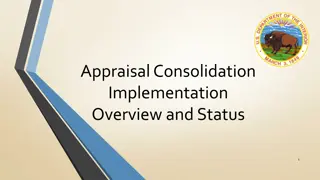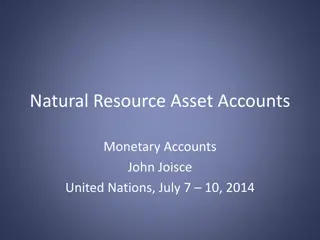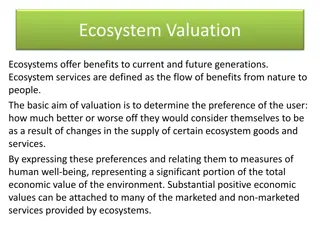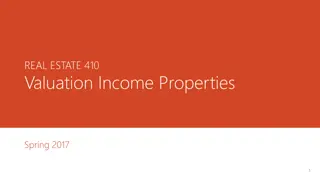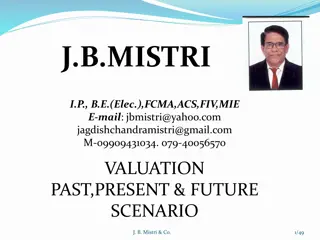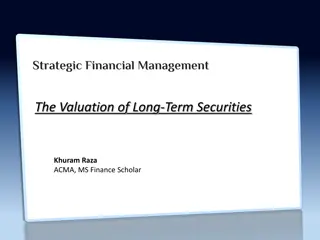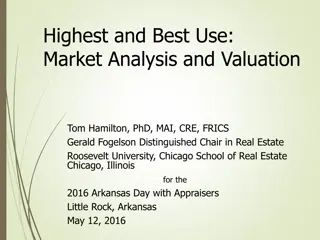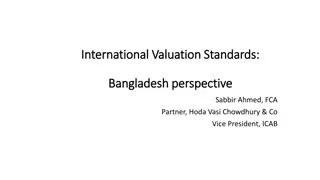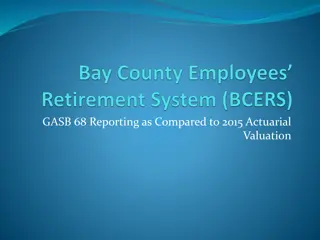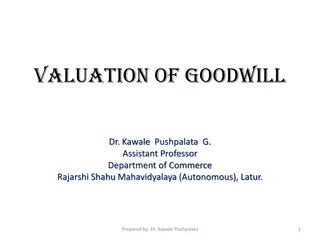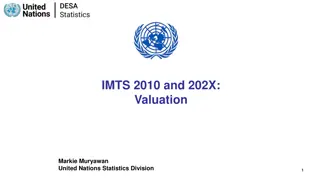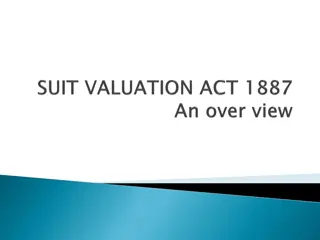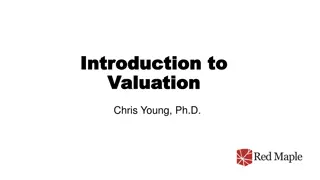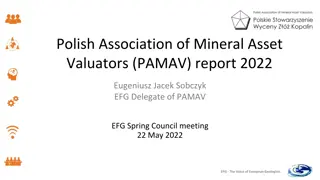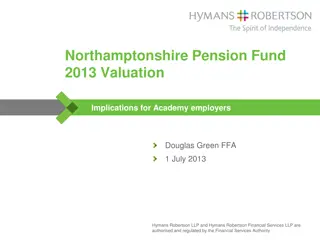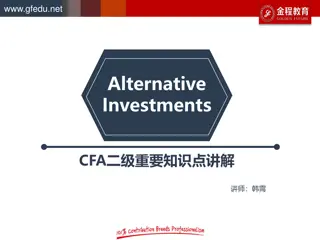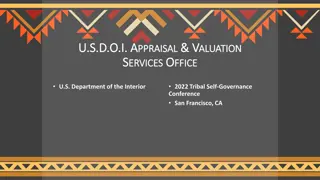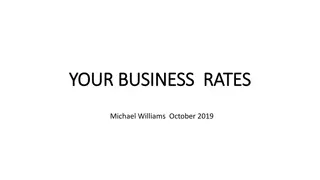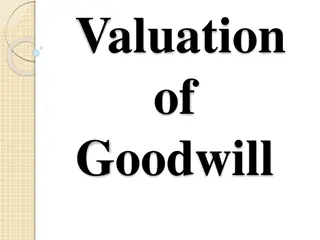Understanding Economic Value and Non-Market Valuation Methods
Economic value goes beyond the price paid, encompassing willingness to pay. Non-market valuation methods help estimate the true worth of goods and services. Misconceptions exist regarding economic value versus economic activity and cost. Valuation exercises aim to enhance societal well-being by understanding people's preferences and trade-offs.
Download Presentation

Please find below an Image/Link to download the presentation.
The content on the website is provided AS IS for your information and personal use only. It may not be sold, licensed, or shared on other websites without obtaining consent from the author. Download presentation by click this link. If you encounter any issues during the download, it is possible that the publisher has removed the file from their server.
E N D
Presentation Transcript
NON-MARKET VALUATION: METHODS AND DATA Peter W. Schuhmann University of North Carolina Wilmington
Outline Introduction What is economic value ? Categories of value Common misconceptions regarding value Benefit-cost analysis Valuation methods & applications Benefits of conducting a valuation exercise Obstacles & budget considerations Gaps and unknowns The way forward? Conclusion
Value and Valuation Economic Value refers not only to what people actually pay, but also includes what people are willing to pay (or give up). Example: you pay $25 for a snorkel trip that is worth $100 to you. The true economic value of this trip is $100. Economic Valuation means estimating what something is worth.
Economic Value Value is most meaningful and measurable in terms of what people are willing and able to give up for the good or service. Value is anthropocentric (human-centered), and the process of valuation is utilitarian: Its purpose is to understand (and hopefully improve) the well-being of people.
Economic Value and Willingness to Accept Oftentimes we lose something of value In these cases, we can look at value as willingness to pay to avoid loss, or willingness to accept compensation for loss. Example: Coastal development may infringe upon society s windows to the sea . The economic value of this loss can be measured as society s willingness to pay to avoid that loss, or the amount of compensation they would be willing to accept to be just as well off with the loss.
Common Misconceptions 1. Economic Value vs. Economic Activity: Economic activity (sales, jobs) is often confused with economic value. The amount of money that changes hands may not reflect the benefits or worth to society. Measures of economic activity often do not account for alternatives that are foregone, and do not take into account goods and services that are not traded in markets.
Common Misconceptions 2. Economic Value vs. Economic Cost The cost of an item or price paid is not always a good reflection of value. For example, it would cost a great deal to transfer 10 tons of sand from Colorado to the Sahara, but the value would be quite low. Similarly, you may pay $20 for a pair of shoes that yields considerably more than $20 in value.
Common Misconceptions 3. Value is only revealed in markets. Goods that are not traded in the marketplace ( nonmarket goods such as clean air, clean water, and healthy ecosystems) have real economic value. Non-market values are more difficult to measure than market values.
Common Misconceptions 4. The Broken Window Fallacy The idea that wars or natural disasters are good for an economy due to the ensuing upswing in economic activity fails to recognize opportunity cost. Money that is spent recovering from disaster (replacing the broken window ) could have been spent on something else. E.g. Jobs that are created in the wake of something bad are not necessarily new jobs , as that labor could have been used for something else.
Summary of Value Value is what something is worth to people. What something costs and the value or benefits it delivers are not necessarily equal. Value need not be revealed in markets. The value of foregone activities ( opportunity cost ) must be considered.
Economic Value & Tradeoffs People derive real economic value from natural resources and the environment for many reasons. Natural systems supply many goods and services that are critical for human well-being. The entire market economy depends on the existence and proper functioning of natural systems.
Ecosystem Services Supportive Services Nutrient Cycling Net Primary Production Pollination and Seed Dispersal Habitat Hydrological Cycle Regulating Services Climate Regulation Hazard Protection Disturbance Regulation Water Regulation Soil Retention Waste Regulation Nutrient Regulation Provisioning Services Water Supply Food Raw Materials Genetic Resources Medicinal Resources Ornamental Resources Cultural Services Recreation Aesthetics Science and Education Spiritual and Historic
Ecosystem service values Despite their obvious importance policy makers often ignore the value of environmental goods and services and their economic and social benefits. Why?
Market Failure Markets do not capture the value of environmental and natural resources due to two common market failures: The characteristics of public goods allow free riders . Traditional market forces break down. External costs created by the production or consumption of market goods are not reflected in the market prices of those goods.
Ecosystem values The value of environmental goods & services goes largely unmeasured because markets do not provide these goods and market prices do not reflect their full value to society. Understanding the full economic value of resources can help inform decisions regarding tradeoffs that society must make.
Components of Economic Value Extractive Use Value Example: Marine Ecosystem e.g.: Fishing Non-Extractive Use Value Use Value e.g. Snorkeling e.g. Erosion protection Indirect Use Value Total Economic Value Value from knowing resource exists Existence Value Value from preserving future use Option Value Non-Use Value Value from preserving for future generations Bequest Value
Non-Use Value / Passive Use Values How do we know that these non-use values are real? We observe that people give up time, money and energy to preserve natural resources that they never use in any tangible way.
Ecosystem valuation Understanding, measuring (and monetizing) environmental contributions to human well-being is the domain of economic valuation. Many situations call for non-market valuation. Valuation does not establish absolute values for the environment. Estimated values constitute lower bounds, and usually only capture the more obvious and readily calculated values.
What are the benefits of conducting a valuation exercise? Having a common unit of measure Uses of natural resources create a range of impacts, usually not in comparable units (generated revenues, changes in fish stocks, loss of tourists, water quality changes, reef degradation). 1. Market Goods Non-Market Goods
What are the benefits of conducting a valuation exercise? Objective decision-making is fostered when all these impacts expressed in the same units. Economic valuation facilitates this comparison by expressing all impacts in monetary units. Coastal development project? Resource damage Jobs -$ +$ vs. Lost tourist visits Revenues
What are the benefits of conducting a valuation exercise? 2. Valuation can be used in conjunction with benefit-cost analysis and provide information that can be used to inform complex management decisions. Political Feasibility Equity/ Fairness Valuation & CBA Policy Decision Time Budget Cultural Concerns
Benefit-Cost Analysis Benefit-Cost Analysis (BCA) is a systematic enumeration of the gains (benefits) and losses (costs) of particular decisions, in common units, for comparison purposes. Helps inform us of the relative trade-offs of alternative resource management strategies and outcomes. Non-market valuation can be an important component of BCA as it informs decision makers about what something is worth (in dollars) or what something will cost (in dollars).
What are the benefits of conducting a valuation exercise? 3. The services provided by the natural environment directly affect human welfare in myriad ways, but are often overlooked by some people and policy makers who only focus on jobs and revenues. Valuation reminds everyone that although that the environment is free , this in no way implies that it is not valuable.
What are the benefits of conducting a valuation exercise? 4. Understanding the incidence of costs and benefits. Who gains? Who loses? When are the gains to be realized? When are the costs to be borne?
Non-Market Valuation: How does it work? Non-market valuation methods require that a link be established between changes in the quantity or quality of the resource and changes in the stated or observed behavior of people. For instance, changes in air quality may result in people moving to another area. Free disposal of rubbish along the coast actually has an impact on beach quality and people s enjoyment and probability of return.
Valuation Methods Over the past 5 decades economists have developed techniques to assess the value of environmental goods. These techniques, which can estimate value for both users as non-users, are being employed intensively throughout the world and are being constantly refined and improved.
Valuation Methods Extractive Use Value Market Data Revealed Preference Methods Non-Extractive Use Value Use Value Productivity or Cost-avoidance Method Indirect Use Value Total Economic Value Stated Preference Methods Existence Value Stated Preference Methods Option Value Non-Use Value Stated Preference Methods Bequest Value
Valuation Methods Because of the complex nature of many environmental goods and natural resources, more than one type of method may be necessary to gain an understanding of all the components of value.
Valuation Scenarios & Examples Scenario Example Assess the potential for user fees Will tourists pay more for environmentally friendly recreation experiences? Measure monetary damages from natural resource degradation Complete a benefit-cost analysis of a conservation project What is the economic loss realized as beach width diminishes? Determine the net economic benefit of increasing use of reef balls or mooring buoys.
Market-Based Valuation The basic idea: Market transactions reveal the value that people assign to goods and services. Empirical approach: Use market prices and quantities to estimated the extractive direct use components of value. E.g. economic contribution of commercial fishery harvests Pros: Relative ease of calculation, defensible value estimates Cons: Difficult to derive estimates of net gains (producer and consumer surpluses), seasonal or geographic variations in value may be obscured through the use of aggregate market measures
Market-Based Methods: The Replacement Cost Approach The basic idea: Some goods and services provided by the natural environment can be replaced by manmade goods and services. Empirical approach: Use market-based estimates of the costs of providing a replacement services as proxies for the value of the associated naturally provided services. Pros: Relative ease of calculation (construction and engineering costs), easily understood. Cons: Not a true means of measuring the value of ecosystem goods and services in the sense of gross or net benefits to people, man-made alternatives are unlikely to fully replace naturally provided goods and services.
Market-Based Methods: The Damage Avoidance method The basic idea: The benefits of maintaining natural resources includes not having to spend money on things that will occur when natural resources are degraded Empirical approach: Use estimates of the (market) expenditures that would have to be incurred to prevent, diminish, avoid, cure or repair harmful effects to human and physical capital as estimates of the natural resources that help us avoid those costs. Pros: Relative ease of calculation, easily understood Cons: Not a true means of measuring the value of ecosystem goods and services in the sense of gross or net benefits to people
Non-Market Valuation: Revealed Preference Techniques The basic idea: People s behavior in markets may help us understand the value of associated non-market goods. Empirical approach: Establish a link be between changes in ecosystem goods and services and changes in observable behaviors of people. Travel Cost Methods Hedonic Pricing
Revealed Preference Methods: The Travel Cost Method The basic idea: The costs incurred in travel represent a lower bound on willingness to pay for access to the natural resource. Empirical approach: Use information on travel expenses and trip frequency to estimate a trip demand function. Use trip demand function to estimate net gains from the resource. Typically applied to recreation Survey data should include: Individual visitation frequency data Travel costs & other expenditures Environmental quality measures Demographic information
Revealed Preference Methods: Random Utility Modeling A version of the travel cost method, RUM uses data on visitation at alternative recreation sites. Uses information on travel to estimate a trip utility (satisfaction) function, based on the idea that individuals will choose the site that gives them the most enjoyment. Survey data should include: Individual visitation data from multiple alternative sites Travel costs & other expenditures Environmental quality measures at each site Demographic information
Travel Cost Method and Random Utility Models Values that can be derived from a TCM or RUM study include: The value of a visit to the visitor over and above the price he already pays (consumer surplus). The recreational value of a natural area (deducted by aggregating the consumer surplus per visit per visitor over all visitors). This is what would be lost when the natural area disappears or is closed for recreation. The value of changes in the quality or characteristics of the recreation site or area.
Revealed Preference Methods: Hedonic Pricing The basic idea: Demand for environmental attributes will be reflected in the prices people pay for associated goods such as housing. Empirical approach: Estimate a function describing how market prices are related to environmental amenities. Real estate sales data should include: House sales prices House characteristics Associated environmental attributes
Revealed Preference Methods Pros: Estimated values are grounded in actual behavior and are therefore empirically defensible. Cons: Data requirements, technical knowledge, limited to easily measured environmental amenities, not suitable for monetization of non-use values.
Stated Preference Techniques The basic idea: People can tell us what they value by answering questions. Empirical approach: Ask people what they are willing to pay or willing to accept or to make hypothetical choices between alternative goods or states of the world. The Contingent Valuation Method Choice Modeling
Stated Preference Methods: Contingent Valuation Survey method whereby people indicate willingness to pay (or accept) for changes described in a hypothetical market. Survey data should include: Detailed description of a program or change Mechanism for eliciting value or choice Payment vehicle Information on respondent attitudes and characteristics
Stated Preference Methods: Choice Modeling Survey method whereby respondent preferences are elicited through a series of choices between alternatives. Alternative goods are described in terms of different levels of attributes. Survey data should include: Description of 2 or more options for a good specified with levels of attributes that make up the product. Respondent attitudes and characteristics Regression estimates for each attribute (and level) represent the part-worth utility (value) for the attribute level compared to a baseline level.
Stated Preference Methods: Choice Modeling Choice Modeling (CM) Recognizes that most environmental goods are composite goods, made up of a variety of attributes that can take on various levels. Allows estimation of the relative importance of multiple environmental attributes and their levels. Generates large quantities of data in a single application. Alternative model specifications can be used to explore preference heterogeneity.
Choice Model example Attributes Levels Price ($US/night) $75, $150, $225, $300 Lodging Type SMALL HOTEL, LARGE HOTEL, APT HOTEL, VILLA Beach Width (meters) 3-5 m, 8-10 m, 13-15 m, 18-20 m Distance to Beach BEACHFRONT, 2-3 Min Walk, 6-8 Min Walk, 18-20 Min Walk Beach Litter (per 25 m) 0, 5, 10, 15
Choice Modeling example Suppose that you could only choose from the lodging options below (Trip A, Trip B or neither trip). If all other factors were equal, which would you prefer? ATTRIBUTES OPTION A OPTION B OPTION C Price ($US) $75 $225 I WOULD NOT Lodging Type Small Hotel Apartment/ Apt Hotel CHOOSE EITHER Beach Width 3-5 Meters Wide 13-15 Meters Wide OF THESE Distance to Beach 12-15 Minute Walk 6-8 Minute Walk OPTIONS 0 Pieces Litter per 25 Meters 10 Pieces Litter per 25 Meters Beach Litter OPTION A OPTION B NEITHER I prefer (check one box)
Stated Preference Methods Pros: Allow for the estimation of values associated with use as well as non-use values, flexible. Cons: Survey data are costly to acquire, high degree of technical knowledge needed for design and estimation, results may be subject to a variety of biases.
Which method is appropriate? Choice of valuation method depends on what is being valued and the intended purpose of value estimates. Policy formation? Building awareness? The benefits derived from a particular ecosystem service may be amenable to valuation using different procedures.
All of this sounds expensive. Is it worth it? The value of valuation lies in providing a more complete accounting of the benefits and costs to society. (Loomis, Choices) Well designed valuation studies allow for the costs and benefits of resource change to be estimated ex ante. Full appraisal of economic costs and benefits will not be the only metric for evaluating policy decisions, but expensive and potentially irreversible decisions should involve a careful consideration of the full range of benefits and costs.
Is valuation worth it? Valuation can also call attention to otherwise undervalued resources. Valuation studies can help policy makers understand the economic costs associated with loss of species and habitats, the benefits of conservation and restoration efforts, or economic dependence on natural systems.
Is valuation worth it? Valuation can help us understand the economic consequences of mismanagement. Resource value estimates can be used to guide policy in the direction of efficient and equitable use, and to create incentives that encourage sustainable use.
Is valuation worth it? Without an understanding of the economic value of natural resources, conservation efforts may be stymied because they are viewed as costly in terms of precluding activities that have large immediate and easily measurable financial rewards.


